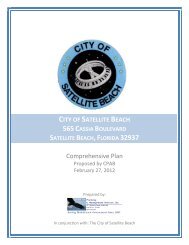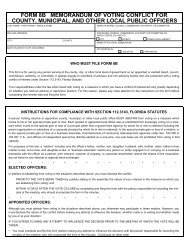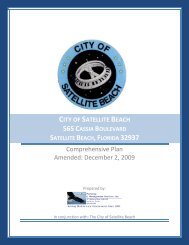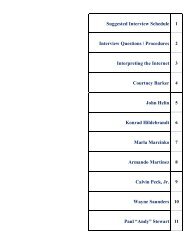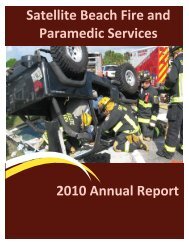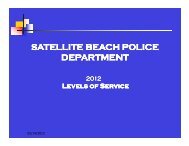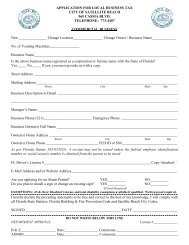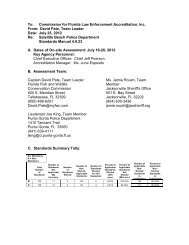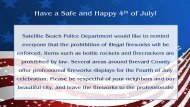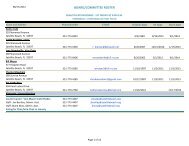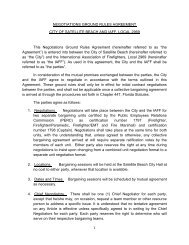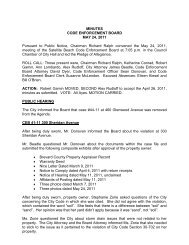Supporting Documents (Data and Analysis) - Satellite Beach
Supporting Documents (Data and Analysis) - Satellite Beach
Supporting Documents (Data and Analysis) - Satellite Beach
Create successful ePaper yourself
Turn your PDF publications into a flip-book with our unique Google optimized e-Paper software.
esulted in a stop to such wastewater discharges from the plants along this portion of the Banana<br />
River. Urbanization within <strong>Satellite</strong> <strong>Beach</strong> <strong>and</strong> surrounding areas has led to increases in impervious<br />
surface (roads, parking lots, etc.), <strong>and</strong> thus increases in non-point source pollution, such as<br />
freshwater runoff, oil <strong>and</strong> grease, eroded soil, nutrients, pesticides, <strong>and</strong> heavy metals.<br />
The Toxic Substances Survey for the Indian River Lagoon System published in 1993 for the St.<br />
Johns River Water Management District <strong>and</strong> the Indian River Lagoon National Estuary Program<br />
documents concentrations of metals, including silver, copper, <strong>and</strong> mercury in sediments <strong>and</strong><br />
cadmium, chromium, <strong>and</strong> mercury in clams, in the Banana River from Patrick Air Force Base to<br />
Mathers Bridge as among the highest in the Indian River Lagoon. The values do not exceed<br />
regulatory st<strong>and</strong>ards, but they are indicative of sources lying in the vicinity of the City.<br />
Due to the nearly complete state of urbanization within <strong>Satellite</strong> <strong>Beach</strong>, there are no palustrine<br />
wetl<strong>and</strong>s within the City, thus the Banana River <strong>and</strong> it estuarine wetl<strong>and</strong> habitats represent the major<br />
natural environmental features of the City. The Banana River has been designated by the Florida<br />
Department of Environmental Protection as an aquatic preserve. The Banana River Aquatic Preserve<br />
Management Plan (1985) designates three ecological community types within the preserve; they are<br />
mangrove areas, marine grassbeds, <strong>and</strong> the salt marsh. The seagrass beds which dominated shallow<br />
waters off the City before the mid-1960s were gone by the mid-1970s, <strong>and</strong> at this time there are only<br />
a few salt marsh areas on Samsons Isl<strong>and</strong> Nature Park. Thus the mangrove fringe around the isl<strong>and</strong><br />
represents the predominant remaining community type within <strong>Satellite</strong> <strong>Beach</strong>. The root structures of<br />
the mangroves stabilize sediments, providing erosion control, <strong>and</strong> serve as a protective nursery area<br />
for many of the finfish <strong>and</strong> shellfish species of the Banana River <strong>and</strong> Atlantic Ocean. Some of the<br />
finfish species which may be found there include tarpon, snook, snapper, <strong>and</strong> ladyfish. Shellfish <strong>and</strong><br />
crustaceans would include blue crab, oysters, shrimp <strong>and</strong> clams.<br />
The goal of the Aquatic Preserves Program is to protect, preserve, <strong>and</strong> manage existing State<br />
submerged bottom l<strong>and</strong>s so that their aesthetic, biological, <strong>and</strong> scientific value may endure for future<br />
generations. Habitat preservation is also linked to the preservation of endangered species. There are<br />
many endangered species which inhabit the City including wading birds, mammals, reptiles, <strong>and</strong><br />
plants. Species which merit closer attention are the West Indian manatee <strong>and</strong> the five species of sea<br />
turtles inhabiting Florida (leatherback, green, Kemp's ridley, hawksbill, <strong>and</strong> loggerhead). The<br />
manatee, protected by State <strong>and</strong> Federal law, is commonly seen in the finger canals, Gr<strong>and</strong> Canal,<br />
<strong>and</strong> Banana River.<br />
The threatened loggerhead sea turtle has historically used the beaches of Brevard County (including<br />
<strong>Satellite</strong> <strong>Beach</strong>) as nesting sites. Nesting densities within the City are not as high as in the southern<br />
portions of the County. This is probably due to the interference of civilization with the nesting<br />
process of the turtle, including pets digging up nests, bright lights disorienting hatchlings, <strong>and</strong><br />
seawalls limiting potential nest sites. <strong>Satellite</strong> <strong>Beach</strong> has enacted an ordinance restricting the use of<br />
outdoor lighting on the beach during nesting season to reduce hatchling mortality.<br />
The abundance of forage provided by the Banana River estuarine environment attracts many<br />
difference species of birds. Although the list is too long to include here, some of the more common<br />
birds which are observed include brown pelicans, cormorants, anhingas, king fishers, osprey, two<br />
Coastal Management/Conservation Element<br />
<strong>Data</strong> <strong>and</strong> <strong>Analysis</strong> 5-12



